Overview of modern earth building
Abstract:
This chapter explains the current position of modern earth building within the construction sector, its appeal and the role it might play in the future. The definition of modern earth building is discussed along with the ways in which this has evolved along with technological advancement and industrialisation. The significance of modern earth building, both for our current and future construction industries, is tackled from developed and developing country perspectives. The chapter then discusses the changing aesthetic of modern earth building including the role this can play in terms of material functionality, before moving on to its position with regard to the changing social morality towards climate change and the construction industry’s response. The chapter ends with a discussion of how earth building approaches have been developed to meet and complement the efficiency requirements of the modern construction industry.
1.1 Introduction
Earth building is simple by its very nature, but ‘simple is hard to do’ as the late Steve Jobs noted on his retirement as CEO of Apple. In modern earth building we are blessed with something simple and worthwhile. Imagine a world where everyone is living and working in insulated or uninsulated rammed earth buildings. That is the norm all over the planet. Everyone has grown up in rammed earth buildings and, because they work so well, no other alternative building materials are ever considered. Then one day an adventurous builder decides that he is going to try building with wood. People think he is crazy. He endures the ridicule, but is determined to give the idea of building with wood a try. His first challenge is to try to figure out how to cut the tree down and then determine which part of the tree is best for building with. He has to invent tools to cut the tree down. He thinks fire might be useful somehow. He is not sure whether to cut the tree into rounds or into lengths. He is not sure how to do this either. He is not sure if there is a difference between the wood of the oak and the wood of the willow. He is a very long way from planed 2 ![]() 4 s and plywood. In the same way, the rammed earth industry is in relatively early stages of development compared to its ultimate potential as a mass-market technique. There is so much innovation beckoning.
4 s and plywood. In the same way, the rammed earth industry is in relatively early stages of development compared to its ultimate potential as a mass-market technique. There is so much innovation beckoning.
The size of the insulated and uninsulated rammed earth market is vast and the technology is ahead of its time. There are still trees to cut down and land with enough topsoil left to grow new trees. We have not yet accomplished on a planetary scale what Lebanon did to their great cedar forests or Easter Island did by cutting down its last tree, but we are working on it. At some point in the future we may not have the option of building with wood and will need to build with inorganic building materials. Of course it is preferable that we make that move while there are still forests and topsoil. As a building culture, we will need to move from veneers to substance, from disposable building and thinking to sustainable communities and healthy environments, and move to the broad use of local materials and labour. The emerging rammed earth industry will need to move from a small capacity cottage industry and levels of building to a much larger economic capability to allow an expanded range and complexity of projects.
Earth building has an honest appeal. Formwork and compaction lines are all there to see – nothing is hidden. Few construction consumables are so simple and honest. Yet it takes courage for many people today to build an earth house. Modern humanity appears to have great faith in highly manufactured and sophisticated elements. Gadgetry that can accompany a simple bushwalk, for example, is sometimes more empowering for a modern-day person than the walk itself. For the modern occupier of an earth house, the walls serve to relax our obsession with neatness, uniformity and linear perfection. While a symmetry of form is retained, the ‘cleanliness’ anxiety created by smooth painted surfaces is excused and somehow deleted. Some primal happiness is restored. It takes courage for many modern building contractors to embrace what can appear to be a step backwards in technology. Earth walling is assumed by many builders to be something that used to happen before the Industrial Age.
There is a real challenge, however, for people to take modern earth building seriously. Modern earth building has the capacity to reduce substantially some of the damaging effects that humanity has on the planet. Earth buildings, in conjunction with good design and clever marketing, could take us towards an acceptable status of smaller and more sensible buildings and will produce a positive and lasting environmental legacy for future generations. The human condition is capable of huge technical ability to overcome some of our most drastic environmental problems. The same condition is also capable of rationalising or justifying extravagant lifestyle choices that have created the problems in the first place. This anomaly in our intelligence is nowhere more evident than in the construction industry. We seek to create environmental solutions with clever low-emission materials and ideas. With these ‘solutions’ under our belt we then build even more extravagant houses for ourselves. This is particularly the case in Australia and the USA where the building space per occupant has increased fourfold over the past 50 years. Earth building has a role to play in creating an awareness of what humanity is capable of in simplifying our housing needs. It serves as a reminder that simple is possible and acceptable. Modern earth building lends status to simplicity, and good earthen architecture gives simple buildings huge credibility.
1.2 Definition of modern earth building
An earth building is one where a significant part of the structure and/or building fabric comprises graded soil (i.e. earth) that has been prepared using one or more techniques, e.g. rammed earth or compressed earth block. However, what characteristics can make an earth building ‘modern’? One of the requirements must surely be that the techniques applied should build on what has been learnt from the past whilst benefiting from the advancements and improvement that state-of-the-art innovation has brought. Since our learning is ongoing it also follows that what constitutes ‘state-of-the-art’ is relative to the era in which the new building is set. A faithful reproduction of a historic form of earth building from the 19th century, for example, that does not benefit from any of the technological or material advancements of the last 200 years cannot be considered as a modern earth building if it is being constructed in the 21st century. A further consideration must be that ‘modern’ earth buildings have a high level of quality, dimensional tolerances and accuracy, compatibility with required/expected fixtures and fittings, compliance with building regulations/codes and scope to excel in best practice and future design standards, e.g. Passivhaus or Cradle to Cradle. This implies that, as our understanding of mix design, material selection and grading, formwork and delivery technology, and the development of new admixtures, binders and coatings continues to progress, then so too will the minimum standard and overall quality of ‘modern’ earth materials. Lastly, the ability of a ‘modern’ earth building to meet the ever-increasing expectations of occupants, in terms of comfort, health/well-being and shelter, should at the very least be maintained and preferably improved. In order to minimise impact and maximise sustainability, this should be achieved with a primary goal of reducing the operational energy towards zero carbon, and a secondary goal of reducing embodied and future demolition/disposal embodied energy.
1.3 The significance of modern earth building in the current and future construction industries
1.3.1 Modern earth building in developed countries
Presently there are few building materials or technologies that offer relief from the world of veneer and artifice. Though there are many reasons that a consumer might select modern rammed earth walling, the beauty and the visceral impact of massive walls made from lightly processed materials trumps them all. The fact that these walls offer healthy indoor environments coupled with energy efficiency, long-life durability with low maintenance, as well as improved acoustics, improved seismic stability and fire barriers, are seldom the determining factors in selecting rammed earth. There is little doubt that consumer patterns of the developed world will rapidly adjust to accommodate the realities of the effects on the planet caused by our lifestyles. In this context modern earth building should be in some demand. There will be current restraints on the modern earth building industry due to its relatively high labour cost. The challenge for the industry in developed countries will be technical: increasing efficiencies and construction safety while ensuring the product retains a low embodied energy. There are endless ways of mechanising the production of earth walls. The challenge will be to engage mechanisation without abandoning the environmental and aesthetic worth of the material.
1.3.2 Modern earth building in developing countries
In developing countries, most of whom have significant earth-walling industries already, the challenge will be one of marketing. A previously impoverished family who have spent generations living in an earth-walled shelter will aspire to live in a ‘modern’ building made from concrete, steel and glass. It may not be enough for the modern earth building to perform extremely well; there will need to be an obvious visual differentiation and one that is aspirational for the end user. In any case, modern earth building in developing countries will be an environmental necessity as a burgeoning middle-class population is likely to place impossible demands on resources for ‘modern’ housing. The role of social marketing in these countries to increase the status of earth building will be vitally important. In many ways the development and increased sophistication of modern earth building in developed countries is likely to significantly enhance the aspirational qualities of these structures in the eyes of developing nations.
1.4 Changes in the modern earth building industry
1.4.1 Aesthetic change
The past two decades have seen a slow uptake in the status attached to environmentally responsible lifestyle choices. In North America, this is the Lifestyles of Health and Sustainability (LOHAS) market segment, and represents approximately 50 million people willing to vote with their wallet. The size, shape and economy of cars, for example, have changed dramatically in recent years. The increase in eco-friendly leisure activities as a market sector is high. Construction materials are changing to reflect the demand for greener credentials, though ironically house size (i.e. m2 floor area) is still increasing in many parts of the world.
The changing aesthetic of modern earth building (in developed countries) as a consequence of our social aspirations has been exciting. Modern earth building has developed within a period of change for the overall construction industry. Earth walling contractors must work with other established building trades to allow for efficient and safe outcomes. Many modern earth buildings have similar shapes to houses made using ‘conventional’ materials, though increasingly architects are making the most of the inherent functional properties that these walls can offer to the operation of a building and interaction with its occupants. In Australia, for example, there is an increasing use of rammed earth on spine walls to bring significant thermal and hygric mass to the core of the building interior whilst allowing lighter, well-insulated elements to clad much of the external fabric. In North America, the potential to use stabilised insulated rammed earth (SIRE) to achieve net zero energy buildings is being applied both in very cold and very hot climates. The humble presence of earth walls in living areas is useful to bring a tactile element to minimalist architecture. Good earthen architecture uses these qualities to create a sense of calm refuge for the occupants. Children love earth walls; watch a child walk up and hug the protruding end of an earth wall. Adults tend to slap the surface of a huge earth wall and feel heartened by the immensity of them. Art works sit comfortably on earth walls; if good art makes us relax into a moment of reflection, then a simple earth wall offers a peaceful place in which to do it.
In all things, good design is about more than just a sense of appearance – it is also about functionality. Humans are smart enough to enjoy the completeness of both the beauty and the function of good buildings. With well-designed earth buildings, this sense of completeness is made apparent. Frank Lloyd Wright was reputed to have said that he felt confident he could design a building that would cause a happily married couple to break up within a year. The acoustics, the smells, the temperature, the humidity, the draughts, the way the eye is moved around the space, the colours and the textures all contribute to (or indeed undermine) our sense of well-being. We are deeply affected by our surroundings, whether we realise it or not. Well-designed modern earth buildings can enhance all of these functions with one material.
As the functionality of modern earth building has been dramatically enhanced over the last few decades, so has there been progress in making available wider visual options. Now it is possible to have rammed earth with or without forming seams, and with or without through-tie holes. There is a level of control now possible on the finished texture of the wall surface (for improved acoustics) and whether or not a surface finish is applied. The colour of the wall can be almost anything desired, although there remains the variability that comes with using a raw material. The use of multi-colour schemes is becoming more popular, despite its expense. Embedding shells and stones in the rammed earth, or carving formwork to create art within the walls has broadened what is available for either the designer or the consumer to express themselves.
1.4.2 Social morality and the response to climate change
Within the context of our current social and economic circumstances, the consumer drives social morality. The construction industry builds to fulfil the demands of that consumer. If the consumer demands small, functionally well-designed, environmentally responsible buildings, the construction industry will build them. If the consumer demand is for larger houses of a particular aesthetic with a high level of energy-consuming technological features, then the building industry will build them. A property developer who builds houses ranging from those with large floor areas and no garden to those with small floor areas and larger gardens, may discover that the large ones sell easily while the smaller ones linger on the market. The market-driven developer learns to build bigger, less environmentally smart houses since they are simply serving a demand. The source of social morality in this case lies with the consumer. Given this predicament, the changing social morality within the context of modern earth building rests less with the construction industry and more with the building consumer.
For the consumer to embrace modern earth buildings they will need opportunities to learn about and experience these options. Opportunities exist for this to happen and many people who understand this point of view are prepared to take the risk by building something different. Well-designed modern earth buildings inevitably make their way into glossy housing magazines, and this serves to educate consumers. This creates some recognition for the consumer to feel confident when their architect suggests, for example, stabilised rammed earth. Carefully placed, understated advertisements for earth buildings in the same magazines will further serve to embolden the earth wall consumer. Once consumers make headway into taking alternative options with their housing, then the industry has a responsibility to provide for the demand efficiently, safely and in an environmentally responsible manner.
The Australian experience towards this transition has been one of incremental progression. The eco-morality of the Australian consumer is changing for the better, and the next generation of consumers have been highly educated about environmentally responsible behaviour. Advertising agencies also appear to be increasingly aware of a changing eco-morality in Australia; advertising writer Michael Mulchay (2011) of DDB Group, Melbourne wrote:
Young consumers are acutely aware of their role in playing their part in protecting our fragile environment. They increasingly feel linked to a bigger system than their own immediate needs.
However the speed with which this morality will affect consumer patterns may be hastened by the financial imperative. Michael Mulchay again stated:
Advertising inevitably speaks to the self interest of the consumer. If modest, well designed buildings prove to substantially reduce living costs, then the market could adapt more frugal and sensible housing choices accordingly. Given the realities of our inevitable ecological challenges, the next generation will look beyond the financial bottom line to consider the ecological bottom line.
From a North American perspective, social morality is seldom the real driver of the modern earth building marketplace. There are, indeed, those who select modern earth buildings for their environmental appropriateness. However, especially in the commercial domain, being able to ‘fly the green flag’ has high commercial importance. Designers or clients want to let the LOHAS market segment know that they are green, and spending money on fibreboard that uses less toxic glue than formaldehyde provides them with little to show off. There are very few visible ways to be green in construction and modern earth excels in flying that flag. As far as the response of the North American construction industry to climate change, most of the big players have repackaged themselves and their products by now. What they make has changed very little. It is hard to think of a single product in a timber frame wall assembly that does not contain formaldehyde, fungicide, volatile organic compounds or phthalates. The focus in the greenbuilding world has been on energy efficiency and recycling. Positive strides have indeed been made in energy efficiency but recycling has not been good for the American home. A recent ruling by the EPA (US Environmental Protection Agency) now allows fly ash to be recycled as a drywall component. This increases the potential risk of exposure to contaminants such as mercury, arsenic and other heavy metals, which fly ash may contain. Most importantly, as the American consumer continues to focus on first cost for big ticket items, the durability of homes and buildings continues to decline. The concept and advantages of the disposable styrofoam cup are now being seen in the disposable American home that is intended to only last the span of the mortgage. It is against this backdrop of ‘normalcy’ that the modern earth building industry competes.
While it may be true that the consumer has a big say in what’s being built, the impacts of those choices will be felt by future generations in the form of toxic waste and resource depletion. If those decisions are not based on complete information and if product manufacturers are permitted to continue to ‘greenwash’, then it falls on the government to ensure complete product information is disclosed. If governments required all structural building products to have a lifespan of 100 years, then modern earth building would overnight become a major industry. Obviously that would be politically very difficult. It is useful to highlight that the current building paradigm is dependent on disposability for its competitiveness. The consumers that we will depend upon to change the market appear to be unaware of this at the moment.
1.5 Managing the demands of the modern construction industry
1.5.1 Structural demands
Modern earth building is still a small part of the overall construction industry in the developed world, though it remains a major player in the developing world. The requirements of modern building codes have meant many traditional earth building methods have fallen behind as they cannot fulfil basic structural requirements such as being load bearing or having high levels of insulation. In his recent book Earth Architecture, Ronald Rael (2009) suggests a political motive behind the demise of some modern earth building cultures:
Increasingly, it is illegal to build with earth because of building codes that are enforced by municipalities. While these decisions are made in the name of safety, it is more likely that manufacturers of industrialised products have lobbied to prevent the use of a free and versatile material such as earth.
Many current Australian building codes make building with uninsulated earth walls almost impossible. This is due to computer modelling based entirely on the steady-state thermal resistance (R-value) of cladding materials. This extraordinary situation exists despite many hundreds of long-term occupants of earth buildings proving they live very comfortably without mechanical air conditioning or heating, and have very low fluctuations in indoor air temperature and relative humidity. Indeed they are, in many cases, proving they live more comfortably and frugally than the occupants of the highly insulated buildings deemed suitable by the current building codes. The technical challenge for modern earth builders will be to heed increasingly rigorous structural building codes and adapt building methods to maintain a competitive edge in the construction market. This needs to be done in a way that does not result in earth building becoming another form of concrete thinly disguised as ‘earth’.
The realities of a diminishing supply of cheap energy-rich building materials such as steel and fired bricks will lend some credence to the future of proper earth building. Currently anything can be built, including modern earth walling, if structural engineers incorporate enough steel and concrete in it. In an increasingly ecologically responsible market place, however, designs will need to be less extravagant as the availability of these structurally useful elements falls away and their cost increases. Without the use of structural steel or concrete bonding systems, earth building can be used extensively by the more modest building market.
1.5.2 Efficiency requirements
It would not be uncommon for a modern earth builder to find themselves on a large commercial building site surrounded by super-fast concrete forming systems, highly mechanised concrete delivery, pre-fabricated structural steel being craned through the air, and observing that the efficiency is far greater compared to current methods in modern earth building. In the context of these efficiencies, the earth building industry has a long way to go. In all developed countries the earth building industry is relatively small. Often it is large commercial projects requiring stabilised rammed earth walling constructed at high delivery rates that have pushed the boundaries and efficiencies of the material to its present limits.
In Australia, commercial projects such as the current RACV (Royal Automobile Club Victoria) Resort at Torquay (see Figs. 1.1 and 1.2), the Port Phillip Estate Winery in Red Hill (Fig. 1.3), the Tarrawarra Art Museum in Healesville (Fig. 1.4), and the Charles Sturt University Campus at Thurgoona have contributed to the advancement of construction efficiencies of the local industry. Precast transportable stabilised rammed earth panels, the development of telescopic handling systems, formwork systems compatible with cladding portal frame steel structures and many other advances are incrementally nudging the industry along.
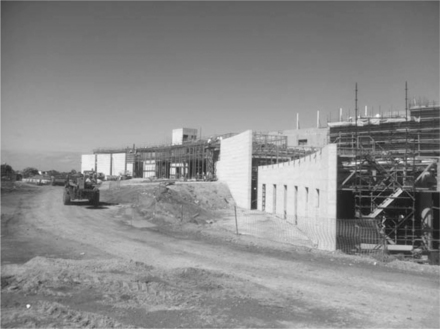
1.1 RACV Project, Torquay, Australia. Insulated SRE cladding a steel portal frame to 11.2 m height using telescopic handler access. (© Earth Structures Pty Ltd, 2011)
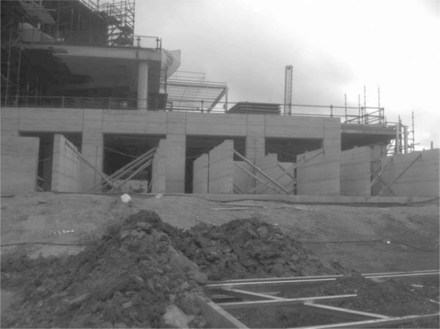
1.2 RACV Project, Torquay, Australia. Precast SRE panels ready for hoisting to Level Three. Cloister walls in background. (© Earth Structures Pty Ltd, 2011)

1.3 Port Phillip Estate, Red Hill, Australia. Facet SRE panels to 12.6 m height. (© Earth Structures Pty Ltd, 2011)
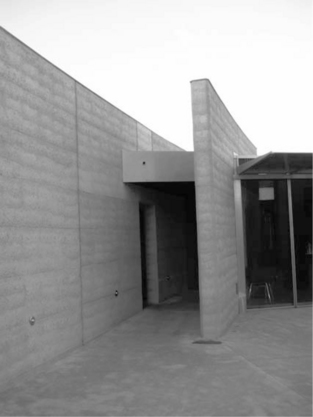
1.4 Tarrawarra Art Museum, Healesville, Australia. Curving panels to 5.4 m height. (© Earth Structures Pty Ltd, 2011)
In North America, commercial projects in very cold climates such as the Southeast Wyoming Welcome Center Wyoming (see Figs 1.5 and 1.6), and Grand Beach (see case study, Chapter 24) have required adoption of previously untried techniques for heating and hoarding, e.g. building inside a tent in the winter (see Figs 1.7 and 1.8). Also, the development of soil design blends that survive extreme temperatures (+ 40 °C to − 40 °C) and quick changes in temperature and humidity. The Nk’Mip Desert Cultural Center required the suspension of almost 100 000 pounds (45 359 kilos) of rammed earth over a glass window opening (see case study, Chapter 24). Due to building seasons that are predicated around winter, the available time to build rammed earth walls can determine if the product can be used. It has happened that the rammed earth price for a project is acceptable but the time frame is not. For that reason commercial projects like Van Dusen Gardens and the South East Wyoming Welcome Center push the industry to adopt and refine different gang forming methods.
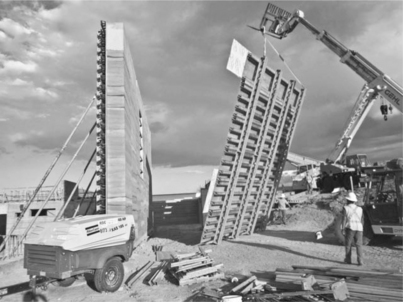
1.5 Formwork stripping at Southeast Wyoming Welcome Center, Wyoming: in order to meet tight timelines, larger panel sizes are useful. (© SIREWALL Inc., 2011)

1.6 Multiple gang forms at Southeast Wyoming Welcome Center, Wyoming: in order to meet tight schedule timelines, it is useful to have multiple walls underway at different stages of the process, thereby keeping the forming team, the ramming team and the mixing teams busy at all times. (© SIREWALL Inc., 2011)
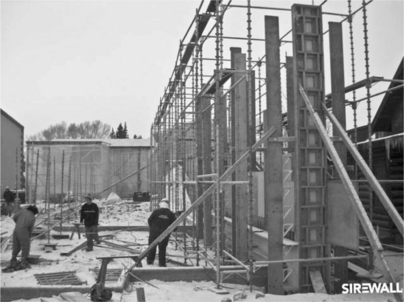
1.7 Sublette County Library, Wyoming: building the heating and hoarding tent using scaffolding. (© SIREWALL Inc., 2011)

1.8 Sublette County Library, Wyoming: the heating and hoarding tent in the snow with air temperatures well below − 30 °C. (© SIREWALL Inc., 2011)
The grand challenge for global modern earth building will be to increase construction efficiencies without abandoning the essential elements that create the difference between earth building and, for example, a highly efficient but ecologically unsustainable concrete block and render industry. The core values that draw people to earth building need to be upheld as the quest for greater efficiencies continues. In a world that is beginning the adjustment to climate change, modern earth building offers resilience to unprecedented changing temperatures, flooding, high winds, fires and rising energy costs. This book offers an insight into some of the sophisticated technologies that are currently available with the intention of broadening the technical credibility of the emerging modern earth building industry.
